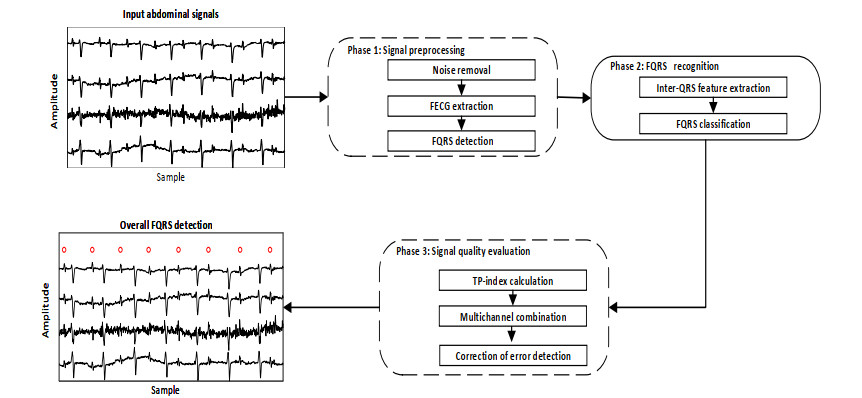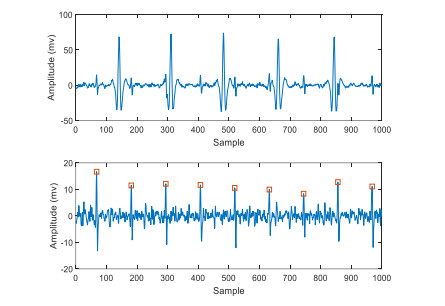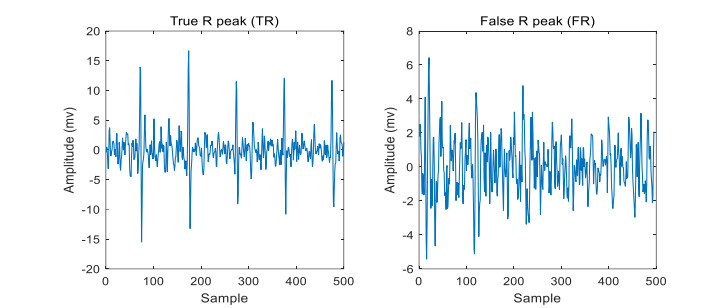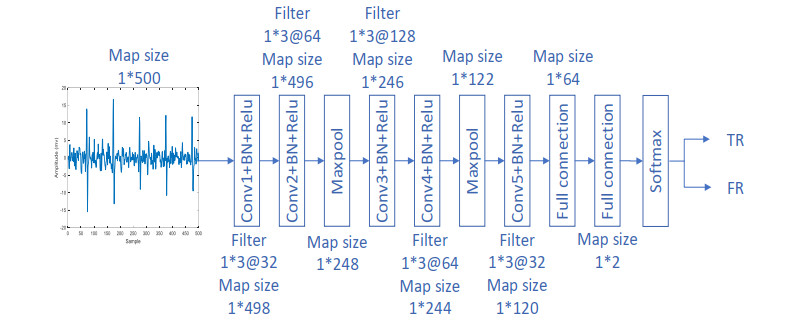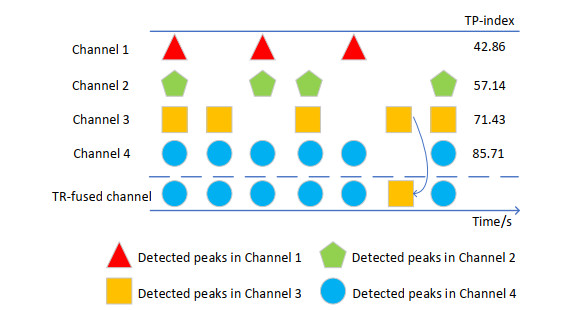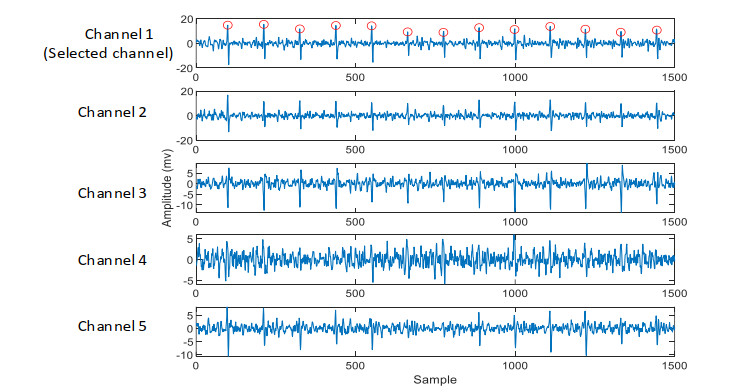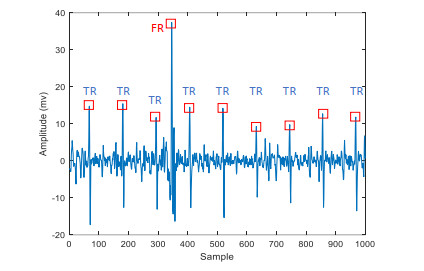1.
Introduction
Non-invasive fetal ECG (NI-FECG) provides a non-invasive method to monitor the health of the fetus in the pregnant women [1,2,3,4]. The NI-FECG collects abdominal ECG (AECG) signals from the abdomen of pregnant women [5,6,7]. The AECG is often contaminated by maternal ECG (MECG), baseline drift and electronic random noise during acquisition [8,9,10]. The overlap of MECG and noise results in a challenging problem of fetal QRS (FQRS) complexes detection[11,12]. This raises a related issue: how to quantify the quality of abdominal signals in the case of low signal-to-noise (SNR)? This work focuses on evaluating the signal quality in the scene of FQRS detection.
Several methods have been proposed to solve the signal quality evaluation problem of adult ECG. These methods include detection-consistency method, energy-based method and statistics-based method [13,14,15,16,17,18]. The goal of the detection-consistency algorithm is to calculate the consistency of two different QRS detectors. Energy-based method is based on calculating the energy of target subband. The objective of the statistics-based method is to analyze the high-order statistics of the ECG data [19,20,21,22,23]. Above methods have achieved some effects on the scenarios of adult ECG. However, the situation of fetal ECG (FECG) is more complicated. Due to the low SNR of FECG data and the overlap of MECG, the performance of the adult ECG method will be reduced. The studies in [24] and [25] try to improve the detection accuracy of the fetal QRS complexes. However, the problem of signal quality assessment is still open.
In this work, we develop a novel approach for NI-FECG signal quality assessment. When the detected peak is the R peak of FQRS, it is a true R peak (TR), otherwise it is a false R peak (FR). False R peak usually comes from the MECG residue or noise. The TR and FR information of a detected FQRS is used as the basic quality information in the context of FQRS detection. Roughly speaking, the FQRS detection result of a good channel should be better than that of a bad channel, because a good channel can provide more TRs. Therefore, we can estimate the quality of a NI-FECG signal by estimating the correctness of the detection results.
As shown in Figure 1, the morphology among the TRs are similar. After removing the maternal ECG, the TRs show a higher morphological similarity compared with the noise or the MECG remnant. Therefore, it is potential to utilize the correlation between FQRS to identify whether the current peak is TR or not. In this work, on the basis of correlation features among the detected peaks, we use an artificial intelligence technique for FQRS classification. An evaluating indicator, denoted TPindex, is applied to assess the quality of the NI-FECG signal. Furthermore, a robust strategy is applied to combine the true peaks of all channels. The combined result is treated as final output for FQRS detection. The contribution of this work is threefold:
● It is a novel signal quality assessment method that can be specifically used to improve the FQRS detection.
● This work provides a solution to select the best channel. Thus, FQRS detection can be carried out more consistently over channels of optimal quality.
● In addition, multi-channel information combination is studied to achieve more effective FQRS detection.
To the best of our knowledge, it is the first work on the use of FQRS correlation for assessing the quality of fetal signal. Because of this, we believe this work makes a contribution to the research community.
2.
Materials and methods
This work presents a signal quality evaluation method that can be used to improve the multi-channel FQRS detection. Figure 2 shows the flow of the signal quality evaluation algorithm, which consists of three phases. Phase 1: Signal preprocessing; Phase 2: FQRS recognition; Phase 3: Signal quality evaluation.
2.1. NI-FECG databases
The NI-FECG data from three databases are used to illustrate the efficiency of the proposed method. These databases include the abdominal and direct fetal electrocardiogram database (ADFECGDB), set a of 2013 PhysioNet/Computing in cardiology challenge database (PCDB) and Daisy database (DDB) [26,27].
● The abdominal recordings in the ADFECGDB database are recorded from five women during pregnancy. A recording contains four channels of abdominal ECG and one channel of scalp ECG. FQRS reference from the scalp ECG is available. The signal is sampled at fs=1 kHz and lasts for five minutes.
● The PCDB database contains 75 abdominal recordings. Each recording has four channels of abdominal ECG with the FQRS reference. The signal is sampled at fs=1 kHz and lasts for one minutes. To date, the PCDB database is the largest publicly available dataset.
●
DDB database consists of five channels of abdominal ECG and three channels of thoracic ECG. The signal is sampled at fs=250 Hz and lasts for 10 s without reference annotations.
As suggested in [22,28], seven AECG recordings (a33, a38, a47, a52, a54, a71 and a74) in PCDB database are discarded because of inaccurate reference annotations. PCDB database is used as training set. ADFECGDB database and DDB database are applied as test set. The training set is used to train a FQRS classification model, and the test set is used to test the trained model.
2.2. Phase 1: Signal preprocessing
A three-step procedure is used to preprocess the AECG signals in this phase. First of all, a band-pass filter is used to eliminate the high-frequency noise and baseline wander. Secondly, the main interference in the abdominal signal, MECG component, is removed to extract the FECG component. Specifically, an open source template subtraction method is used for FECG extraction [27,29]. Researchers can choose different FECG extraction methods according to their own tasks. This does not limit the use of the proposed method, because the evaluation of signal quality is carried out after the FECG extraction operation. Finally, we use a QRS detector to detect the location of the FQRS complexes [30].
As shown in the Figure 3, the extracted signal consists of fetal signal and some noise after the FECG extraction. Such that the potential R peak of FQRS can be detected on the extracted signal channel.
2.3. Phase 2: FQRS recognition
In this phase, FQRS recognition consists of two steps. In step 1, association features are constructed from the detected fetal peaks. A classification algorithm is used to identify the detected FQRS in step 2.
Step 1 focuses on constructing the association features. For high-quality signals, the fetal waveform has a high SNR compared with the noise signals around it after the FECG extraction operation. In order for the model to learn this pattern, 200 ms data before and after the potential location of FQRS are extracted as features of single FQRS. The features of several adjacent FQRS are combined as the association features, which indicates the inter-QRS correlation of adjacent FQRS. Specifically, features of detected fetal peaks with index i∈[j−β,j+β] are used as the association features of the j-th detected FQRS. It represents the waveform similarity between the detected FQRS and its surrounding 2β FQRS complexes. For better real-time effect of the algorithm, the parameter β is set to 2. The size of association feature is 1∗500 when the sampling frequency is 250 Hz. Each association feature is given a quality label of TR or FR. As shown in the Figure 4, compared with the noise, the waveform similarity between true peaks is higher.
In step 2, a convolutional neural network (CNN) classifier is applied to distinguish whether the detected peak is true R peak. The CNN classifier has achieved excellent performance in many areas such as medical image classification and arrhythmia detection [31,32]. In this work, the CNN classifier takes the inter-QRS features as input and outputs a sequence of quality labels P=[p1,p2] (TR or FR).
Figure 5 shows the structure of the CNN classifier. The CNN classifier contains five convolutional layers (Conv1-Conv5), two fully connected layers and a softmax layer. The parameter of the convolutional layer (a*b@c) in the CNN model in Figure 5 indicates that the filter size is a*b and the number of filters is c. Convolutional layers perform α convolutions between convolutional filter wi and the feature map v,
where si(n) corresponds to the n-th parameter of the i-th feature map of output. The wi(m) corresponds to the m-th weight of the i-th convolutional filter.
Each convolutional layer is followed by a batch normalization (BN) and a Relu function. The Relu function can be formulated as,
The convolutional output of a layer can be formulated as,
where oi(n) is the n-th parameter in the i-th feature map of output, and the bi is the term of bias.
The loss function is the cross-entropy function, which is defined as
where r and p are the actual output and target output, respectively. Table 1 provides the parameters of the CNN classifier. Specifically, the input size and output size are 1*500 and 1*2, respectively. Filter size of all the convolutional layers is 1*3. Stride size is set at 1, and the number of filters in Conv1-Conv5 are 32, 64, 128, 64 and 32, respectively. A stochastic gradient descend (SGD) optimizer with learning rate 10−4 is used to train the CNN model. Overall, the trained CNN classifier maps a sequence of features to two sample classes, which can identify whether a detected FQRS is a true peak.
2.4. Phase 3: Signal quality evaluation
After identifying the detected fetal peaks, the signal quality of the NI-FECG is evaluated in this stage. A good signal channel should have more TRs for FQRS detection than a bad channel. We propose a true R peaks indicator, denoted TPindex, to evaluate the quality of the NI-FECG signal. TPindex is formulated as,
where NTR corresponds to the number of detected FQRS classified as true peaks. NFQRS corresponds to the number of all detected FQRS.
Intuitively, the TPindex represents the percentage of classified true peaks in a lead of NI-FECG signal. It indicates the channel's ability to offer TRs among all detected FQRS it provides. In other words, data with higher TPindex has better signal quality. Then the signal with higher TPindex value has the potential to provide better performance in FQRS detection. The best lead for FQRS detection can be obtained by selecting the channel with the highest TPindex.
TPindex provides a solution to select the best channel for FQRS detection. However, due to the influence of noise, the optimal channel cannot guarantee that the FQRS can be effectively detected all the time, while other channels may detect the FQRS in this period. Therefore, the fusion of multi-channel results can provide more accurate FQRS detection performance. In this work, a robust strategy is used for multi-channel information fusion from all available channels.
Figure 6 shows the procedure of multi-channel information fusion. After the FQRS recognition, we collect the TRs from the detected fetal peaks of all available channels. TRs in the channel with the highest TPindex value (Channel 4 in Figure 6) is used as the basic FQRS of TR-fused channel, and the FRs are not used in the later processing. Distance between two detected peaks can be calculated from the fetal heart rate (FHR),
where F∈(FL,FH) is the FHR. D∈(DL,DH) is the distance between two FQRS. As suggested in [33], the lower limit of FHR FL is set to 110 bpm and the upper limit FH is set to 180 bpm.
The distance between two FQRS in the TR-fused channel can be assessed as,
When this formula is satisfied, it indicates that there are fetal peaks in the TR-fused channel that are not detected. The detected peaks of other channels can be considered to be added to the corresponding interval of the fusion channel. When selecting the TRs of a channel, the priority of the channel can be set based on the TPindex value (Channel 3 in Figure 6).
After the multi-channel TRs combination, there may be wrongly detected fetal beats or missed fetal beats in the fusion channel. Here an operation based on the distance between two detected peaks is used to correct the false positive (FP) and false negative (FN). FP represents the wrongly detected fetal heart beats. FN represents the missed fetal heart beats. The distance between two FQRS complexes is assessed as,
When this formula is satisfied, it indicates that there is a FQRS complexes in the TR-fused channel that are wrongly detected. Two fetal beats corresponding to the interval can be discarded. The Eq (2.7) is used to check the FN of fusion channel. When the Eq (2.7) is satisfied, several wave peaks can be placed in the corresponding intervals. Finally, the fused channel integrating multi-channel information can be used for reliable FQRS detection.
2.5. Evaluation metrics
Positive predictive value (PPV), Sensitivity (SE) and F1 are usually used as the evaluation metrics for FQRS detection [23,27,32]. The definitions of these metrics are given by
where TP is the number of correctly detected FQRS complexes. FP is the number of wrongly detected FQRS complexes. FN is the number of missed FQRS complexes. The PPV measures the proportion of true FQRS that have been detected out of all the detected FQRS in a channel. The SE measures the proportion of true FQRS that have been detected out of all the true FQRS in a channel. The F1 measures the harmonic mean of PPV and SE.
3.
Results
Table 2 summarizes the experimental results of FQRS complexes detection on ADFECGDB database. In the multi-channel fetal heart monitoring scenario, each channel can provide a monitoring result. The goal of a channel selection method is to select the channel with the best FQRS detection result. Therefore, the results of the actual best channel (Best channel in Table 2) are compared with the proposed method in this paper. It represents the best results that a channel selection method can achieve. In order to show the effect of the proposed method in selecting high-quality signal channels, the results of the selected optimal channels (Selected channel in Table 2) are shown in the table. Furthermore, the results of the fused channels (Fused channel in Table 2) demonstrates its ability in multi-channel information fusion.
It can be noted that the channel selection performance of the proposed method on ADFECGDB database are 95.87% PPV, 96.88% SE and 96.37% F1, respectively. Multi-channel fusion performance of the proposed method on ADFECGDB database are 97.40% PPV, 98.33% SE and 97.86% F1, respectively.
Figure 7 shows the results of FQRS complexes detection on DDB database. It can be seen that the proposed method can select high-quality signals (Channel 1 in Figure 7), which is helpful to obtain reliable FQRS detection results. The proposed method is also compared with the other three methods in Figure 8. These methods include detection-consistency method, energy-based method and statistics-based method [14,15,20]. Results show that the proposed method achieves the best performance.
4.
Discussion
Electronic monitoring system is prone to noise in the process of prenatal monitoring. It is important to distinguish between signals of good quality and signals of poor quality. Otherwise, the wrongly detected FQRS in the poor quality signals would reduce the effectiveness of FHR estimation when an automated algorithms is used for fetal monitoring. In this study, a signal quality evaluation method is specifically designed to improve the FQRS detection.
Because of the strong interference of the MECG, eliminating the MECG is a routine operation of signal preprocessing. So the quality evaluation of the NI-FECG signal is carried out on the residual signal after the signal preprocessing. The residual signal can intuitively represent the signal quality of fetal component and provide reliable results for FQRS detection. Figure 9 shows an illustration of error detection. In the process of fetal ECG extraction, if the maternal ECG is not effectively removed, the residual maternal ECG components are often incorrectly detected as the FQRS. As shown in Figure 9, the proposed algorithm can effectively identify this situation. Based on the ability on FQRS recognition, CNN classifier can distinguish the error detection as FR. By getting the exact location of the error detections, the proposed method can accurately reflect the data mutation and provide the status of signal quality in a real-time manner.
In the multi-channel fetal monitoring scene, the status of signal quality varies from channel to channel. Effective technology is required to select signals with good quality. For example, in the task of fetal ECG extraction, selecting good signals is helpful to extract clear fetal ECG waveforms. The method in this paper provides a new solution for the selection of high-quality channels. Specifically, the TPindex is applied to reflect the overall status of a NI-FECG channel. At the same time, a TPindex-based method is also presented for best channel selection. It can be noted in the Table 2 that the results of the selected channels are comparable with the results of the actual best channel. These results indicate that the method can tell whether the signal quality is good or bad.
Multi-channel FQRS combination is also considered in this work. NI-FECG is easily interfered by various noises. Therefore, FQRS may not be available in some parts of the channel, making error detection inevitable. Even the signal with the best quality may have error or missed detection fragments. At this time, other channels may accurately detect the fetal peaks. It is possible to use multi-channel FQRS combination and correction of error detection to further improve FQRS detection results. Considering these aspects, a robust strategy is presented to fuse the multichannel FQRS. Specifically, combining the FQRS detection results of all available channels can be used for more reliable fetal heart monitoring. As shown in the Table 2, the performance of the fused channel is better than that of the actual best channel through the effective fusion of multiple channels.
FQRS detection has important clinical value in fetal monitoring. It can provide accurate information of fetal heart rate to diagnose arrhythmia, making the timely disease intervention possible. Selecting an effective FECG extraction method can help to obtain good results on FQRS detection. However, when the signal quality of all channels is poor, even the best channel is hard to provide good FECG for FQRS detection. The future work should study the method to improve the efficiency of fetal ECG extraction under the condition of poor signal quality.
5.
Conclusions
In this contribution, a signal quality evaluation method is presented for the task of FQRS detection. Since the TPindex can evaluate the quality status of NI-FECG signal, it can be used to select the channel with good quality. Further, a robust strategy is investigated to combine multi-channel FQRS complexes. Results on two clinical datasets indicate that the technique can effectively evaluate the signal quality of NI-FECG and improve the performance of FQRS detection. It has a promising application in automatic identification of reliable signals for fetal monitoring.
Acknowledgments
This work was supported by the Young Innovative Talents Projects in Ordinary Colleges and Universities in Guangdong Province (No. 2021KQNCX059), Basic and Applied Basic Research Project of Guangzhou Basic Research Program (No. 202201011295), Characteristic Innovation Projects of Ordinary Colleges and Universities in Guangdong Province (No. 2020KTSCX087).
Conflict of interest
The authors declare there is no conflict of interest.
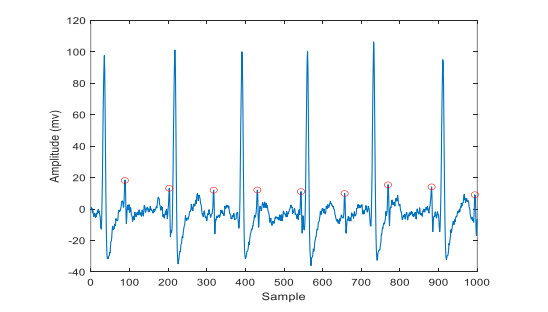









 DownLoad:
DownLoad:
